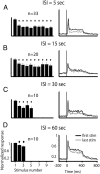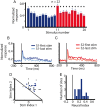Stimulus-specific adaptation: can it be a neural correlate of behavioral habituation?
- PMID: 22159097
- PMCID: PMC6634140
- DOI: 10.1523/JNEUROSCI.4790-11.2011
Stimulus-specific adaptation: can it be a neural correlate of behavioral habituation?
Abstract
Habituation is the most basic form of learning, yet many gaps remain in our understanding of its underlying neural mechanisms. We demonstrate that in the owl's optic tectum (OT), a single, low-level, relatively short auditory stimulus is sufficient to induce a significant reduction in the neural response to a stimulus presented up to 60 s later. This type of neural adaptation was absent in neurons from the central nucleus of the inferior colliculus and from the auditory thalamus; however, it was apparent in the OT and the forebrain entopallium. By presenting sequences that alternate between two different auditory stimuli, we show that this long-lasting adaptation is stimulus specific. The response to an odd stimulus in the sequence was not smaller than the response to the same stimulus when it was first in the sequence. Finally, we measured the habituation of reflexive eye movements and show that the behavioral habituation is correlated with the neural adaptation. The finding of a long-lasting specific adaptation in areas related to the gaze control system and not elsewhere suggests its involvement in habituation processes and opens new directions for research on mechanisms of habituation.
Figures








Similar articles
-
Stimulus-specific adaptation, habituation and change detection in the gaze control system.Biol Cybern. 2012 Dec;106(11-12):657-68. doi: 10.1007/s00422-012-0497-3. Epub 2012 Jun 19. Biol Cybern. 2012. PMID: 22711216 Review.
-
Responses to Pop-Out Stimuli in the Barn Owl's Optic Tectum Can Emerge through Stimulus-Specific Adaptation.J Neurosci. 2016 Apr 27;36(17):4876-87. doi: 10.1523/JNEUROSCI.3339-15.2016. J Neurosci. 2016. PMID: 27122042 Free PMC article.
-
Stimulus-specific adaptation in the gerbil primary auditory thalamus is the result of a fast frequency-specific habituation and is regulated by the corticofugal system.J Neurosci. 2011 Jun 29;31(26):9708-22. doi: 10.1523/JNEUROSCI.5814-10.2011. J Neurosci. 2011. PMID: 21715636 Free PMC article.
-
Stimulus-specific adaptation to visual but not auditory motion direction in the barn owl's optic tectum.Eur J Neurosci. 2017 Feb;45(4):610-621. doi: 10.1111/ejn.13505. Epub 2017 Jan 17. Eur J Neurosci. 2017. PMID: 27987375 Free PMC article.
-
Stimulus specific adaptation in inferior temporal and medial temporal cortex of the monkey.Behav Brain Res. 1996 Apr;76(1-2):191-7. doi: 10.1016/0166-4328(95)00197-2. Behav Brain Res. 1996. PMID: 8734053 Review. No abstract available.
Cited by
-
Large-scale synchronized activity during vocal deviance detection in the zebra finch auditory forebrain.J Neurosci. 2012 Aug 1;32(31):10594-608. doi: 10.1523/JNEUROSCI.6045-11.2012. J Neurosci. 2012. PMID: 22855809 Free PMC article.
-
Deficits in auditory predictive coding in individuals with the psychosis risk syndrome: Prediction of conversion to psychosis.J Abnorm Psychol. 2020 Aug;129(6):599-611. doi: 10.1037/abn0000513. J Abnorm Psychol. 2020. PMID: 32757603 Free PMC article.
-
Autonomous Flying With Neuromorphic Sensing.Front Neurosci. 2021 May 14;15:672161. doi: 10.3389/fnins.2021.672161. eCollection 2021. Front Neurosci. 2021. PMID: 34054420 Free PMC article.
-
Responses of tectal neurons to contrasting stimuli: an electrophysiological study in the barn owl.PLoS One. 2012;7(6):e39559. doi: 10.1371/journal.pone.0039559. Epub 2012 Jun 20. PLoS One. 2012. PMID: 22745787 Free PMC article.
-
Stimulus-specific adaptation and deviance detection in the inferior colliculus.Front Neural Circuits. 2013 Jan 17;6:89. doi: 10.3389/fncir.2012.00089. eCollection 2012. Front Neural Circuits. 2013. PMID: 23335883 Free PMC article.
References
-
- Arthur BJ. Distribution within the barn owl's inferior colliculus of neurons projecting to the optic tectum and thalamus. J Comp Neurol. 2005;492:110–121. - PubMed
-
- Bala AD, Takahashi TT. Pupillary dilation response as an indicator of auditory discrimination in the barn owl. J Comp Physiol A. 2000;186:425–434. - PubMed
-
- Bala AD, Spitzer MW, Takahashi TT. Prediction of auditory spatial acuity from neural images on the owl's auditory space map. Nature. 2003;424:771–774. - PubMed
Publication types
MeSH terms
LinkOut - more resources
Full Text Sources
